We include products we think are useful for our readers. If you buy through links on this page, we may earn a small commission. Here’s our process.
Greatist only shows you brands and products that we stand behind.
Our team thoroughly researches and evaluates the recommendations we make on our site. To establish that the product manufacturers addressed safety and efficacy standards, we:- Evaluate ingredients and composition: Do they have the potential to cause harm?
- Fact-check all health claims: Do they align with the current body of scientific evidence?
- Assess the brand: Does it operate with integrity and adhere to industry best practices?
I avoided yoga through high school, probably because I was a teenager and it was something my mom was trying to get me to do. But I picked it up in college when I was no longer playing sports and needed an outlet for my energy.
I quickly fell in love with the practice — it made me feel stronger and calmer, and I started sleeping better. Now I try to get to yoga at least twice a week and do an online video on the days when I can’t make it out (read: when it’s under 30 degrees).
But yoga can be intimidating to those new to it, and I wanted to shed some light on what it’s all about, including some beginner poses to try.
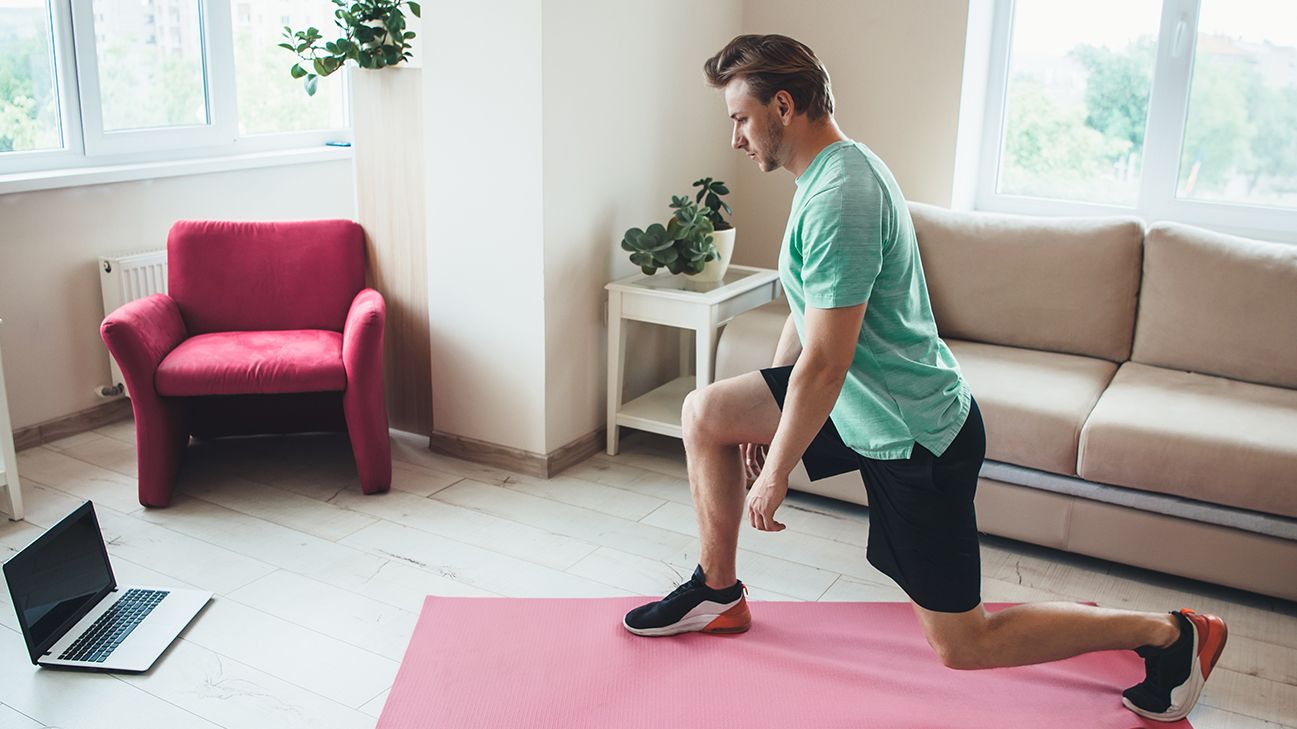
When it comes to yoga, there’s absolutely no need to start with challenging inversions or complicated poses. In fact, you never have to do them if you don’t want to. There are benefits to easier yoga poses, especially for stretching and relaxation.
Here are a few basic yoga poses to get you started.
1. Down Dog on a chair (Uttana Shishosana)
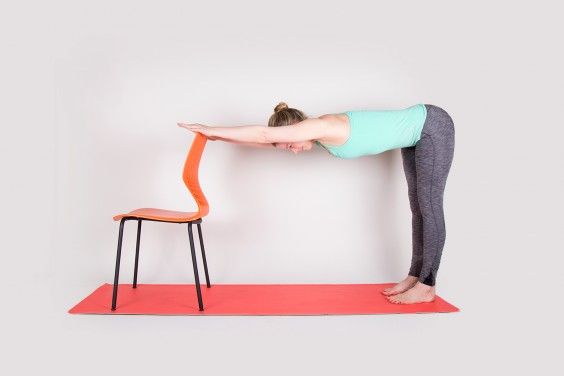
How to do this pose:
Using the back of a chair, stand with your feet shoulder-width apart. Step back, keeping your spine parallel to the floor until you’re in a 90-degree angle. Gently lengthen your back toward your hips.
2. Child’s Pose (Balasana)
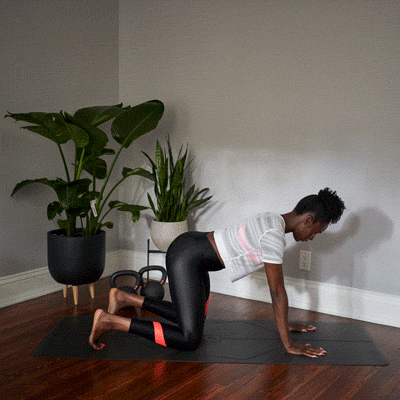
How to do this pose:
Kneel with your knees shoulder-width apart. Your toes can curl in as shown or lie flat on the mat. Reach your arms forward, your hips back, and your head to the floor to feel the stretch.
If it feels like too much, you can modify it by placing a rolled-up towel behind your knees to rest on.
3. Happy Baby (Ananda Balasana)
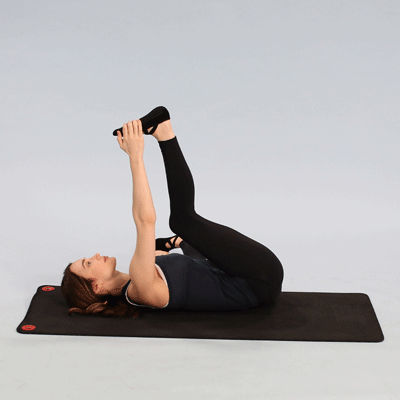
How to do this pose:
Lie on your back and bring your knees up closer to your body. Grab the edges of your feet (or your ankles or shins if that’s too challenging), and separate your knees as far as is comfortable. Gently rock from side to side. Try to keep the length of your spine on the floor, especially the tailbone area.
4. Bound Angle Pose (Baddha Konasana)
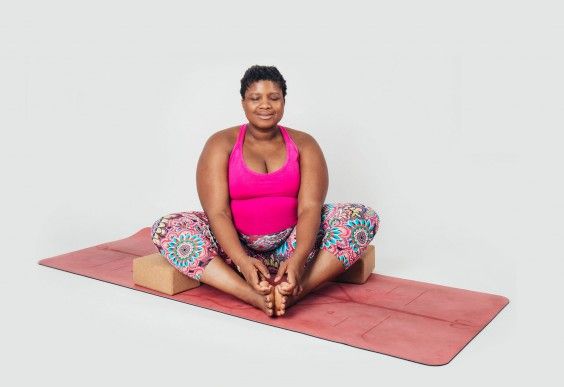
How to do this pose:
Sit on the floor and bend your knees to bring the soles of your feet together. Bring your heels as close to your pelvis as is comfortable, or until you feel the stretch.
Bring your torso down toward your feet to lengthen your back muscles. Try to keep your spine straight and not rolled forward. The pose pictured is modified with yoga blocks.
5. Cat-Cow (Marjaryasana-Bitilasana)
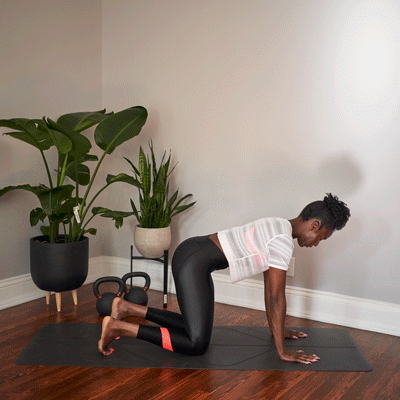
How to do this pose:
Start on your hands and knees (or lean on your forearms if this pose feels uncomfortable). Arch your back gently up while tucking your head down into Cat Pose.
Lift your tailbone and lengthen your chest forward while dropping your belly down into Cow Pose. Hold for a few seconds, and then return to the starting position.
Breathing into your little toe (or any other body part)
I asked Lauren Larry, founder of Sunny Sankalpa Yoga, what it means when a teacher says to breathe into your toe or your hip or any body part that’s not a lung.
“This is actually a descriptor that I found confusing as a yoga student,” Larry says. “When you ‘breathe’ into a part of your body, picture the body part and relax the muscles around it.”
“As you bring awareness to that area of the body, contract and release the muscle you’re focusing on. Bring awareness to the body part mentioned in your inhale, and release tension on the muscles on your exhale. When you release tension in that muscle, you’re ‘breathing’ into the muscle.”
Ann Swanson, a certified yoga therapist and the author of Science of Yoga, adds, “This is just a visualization to help bring your awareness to the area, increasing interoception, or internal body awareness. You cannot actually ‘breathe into’ a body part except your lungs. For that reason, I prefer to add ‘imagine’ before a cue like that.”
Breathing into a part of your body other than your lungs is impossible, but by bringing awareness to a certain part of your body, you can send energy to it.
Andrea Trank, founder of Heaven Lane Healing & Creative Arts, which provides customized yoga lessons and lifestyle coaching, says, “Energetically, when you breathe into an area, you are sending energy, attention, and possibly healing to this area. When you are moving as you do in yoga, with breath awareness, you are helping to circulate freshly oxygenated blood to all parts of your body involved in the practice.”
Setting an intention
I often feel panicky (definitely not the feeling yoga is intended to evoke) when teachers instruct the class to “set an intention.” From this anxiety comes a certain level of snark, and my intention can end up being something as thoughtless as “just let me make it through this class.”
I realized this anxious feeling arises because I’m not clear on what it means to set an intention and I worry I’m the only one doing it “wrong.” I remember feeling this way in math class when we were learning proofs — I had such trouble grasping the concept that I didn’t even know what questions to ask to get a clearer understanding.
Ever been there? Yeah, it sucks. So, what exactly does it mean to set an intention?
“I often start a yoga class by asking my students if they want to set an ‘intention’ for their practice.” Trank says. “It could be for yourself, a friend in need, or something that is needed by the world. It allows your practice to be more than just a physical asana practice. It becomes a spiritual practice as well.”
Ali Owens, a certified yoga instructor and contributor to the yogawakeup app, tells her students that setting an intention can be a powerful way to bring meaning to your practice, whether by connecting with your breath or adding more love and joy to your life.
Setting an intention can be as simple as focusing on one word during your practice. Some people may focus on “ease” or “peace” or “love.”
The Sanskrit name for intention is “Sankalpa.”
“This is the deepest desire of your heart. It’s more than a goal of nailing a headstand,” Larry says. “It’s the embodiment of what you would like to manifest in life. It’s a word, a phrase, or even an emotion you would like to embody.”
She continues, “Find something you want in the big picture of your life, like grace under fire or forgiveness. When you pick your intention, come back to it during class. You’ll notice your classes have a new meaning.”
One word seems manageable to me!
Chanting 101
I used to lip-sync in classes that began with chanting, just like I used to mouth the words to “Happy Birthday” every time it was a co-worker’s birthday. (I say “used to” here because I work from home now and my dog doesn’t care that I can’t carry a tune.)
I’ve gotten over this self-consciousness in yoga class, but I still sometimes feel silly letting the “om”s fly. So, why is chanting beneficial?
It turns out that chanting “om” can actually switch your brain into relaxation mode. One 2016 study suggests that chanting “om” for 10 minutes can have a positive effect on mood and social cognition. And a 2019 study suggests that religious chanting could have psychotherapeutic effects.
It may just be worth adding a chant to your yoga routine.
Inverted poses… and your period
I’ve had a few teachers who have offered alternative poses during the inversion part of class for anyone who is on their cycle. I always find this to be a bit of an awkward announcement that I have my period, much like the time I accidentally dropped three tampons in the middle of a crowded Starbucks and then walked out.
Is it true that for 1 week each month, I should pass on the headstand?
“There is no known medical reason to not do inversions while on your period. Currently, there is not convincing evidence that it would cause endometriosis or any health issues,” Swanson says.
She continues, “It may just simply be uncomfortable, especially if you are not used to inversions. According to yoga philosophy, going upside down may affect the natural downward flow that should happen during menstruation (apana vayu), but even with that, we can’t be sure if the subtle energy works that way, because we have no way to measure it.”
Owens adds, “When we invert, we send energy and blood upwards towards your heart and head, which can be great for circulation but counterproductive during your cycle. I have also found in my own personal practice that I feel a lack of willingness and sometimes ability to engage the muscles necessary to support my inversion practice.”
There’s really no evidence that any harm will come from inverting during your period — the larger concern is that it just may not feel great.
As Trank says, “I think the key is not to follow fast rules but to pay close attention to your body and be mindful of how each of the poses feel.” Do what feels right for you and your body each day.
Savasan-uhhhh… I wanna leave this class
I often find myself close to dosing off during Savasana (the final resting pose), especially if it’s an evening class. Or, worse (and this happens during midday classes), I’m anxious for Savasana to end so I can get on with my day. When I’m practicing at home, I never include this step.
I reasoned that if I learned what Savasana was doing for my mental and physical health, I may be able to think of it as more than a precursor to a nap or something impeding me from getting to the nonessential errands and manicure I have planned post-class.
But Larry explains that the “work” of yoga begins with Savasana.
“After the pranayama (breathing) and asana (postures), our bodies need to settle into themselves. Savasana isn’t a nap time, it’s a connection of mind, body, and spirit. Your body receives much-needed rest, and the yoga teacher guides your mind into stillness so you can connect fully.”
She continues, “You’ll notice your mind wants to be busy, but if you focus on your breathing, your mind will settle into stillness. It takes a lot of practice and dedication to get to that point.”
Savasana can be even more important than the active practice.
“Commonly known as Corpse Pose, it is a chance to mentally, physically, and spiritually consolidate all you have learned in your yoga practice that day,” Trank says. “It is a difficult pose because you are resting yet alert. If you skip Savasana, often your yoga practice feels incomplete.”
Yoga has come a long way since my living room in the early ’90s. There’s now drunk yoga, acroyoga, and even goat or puppy yoga. And as Francis Bacon said, knowledge is power. Learning more about the yoga cues you hear will only deepen your practice and improve your form.
The instructors I talked to all emphasized how important it is to listen to and trust your body before you follow any hard and fast rules.
Grace Gallagher is a writer living in Portland, Oregon. All of her work can be found at www.gracelgallagher.com.

